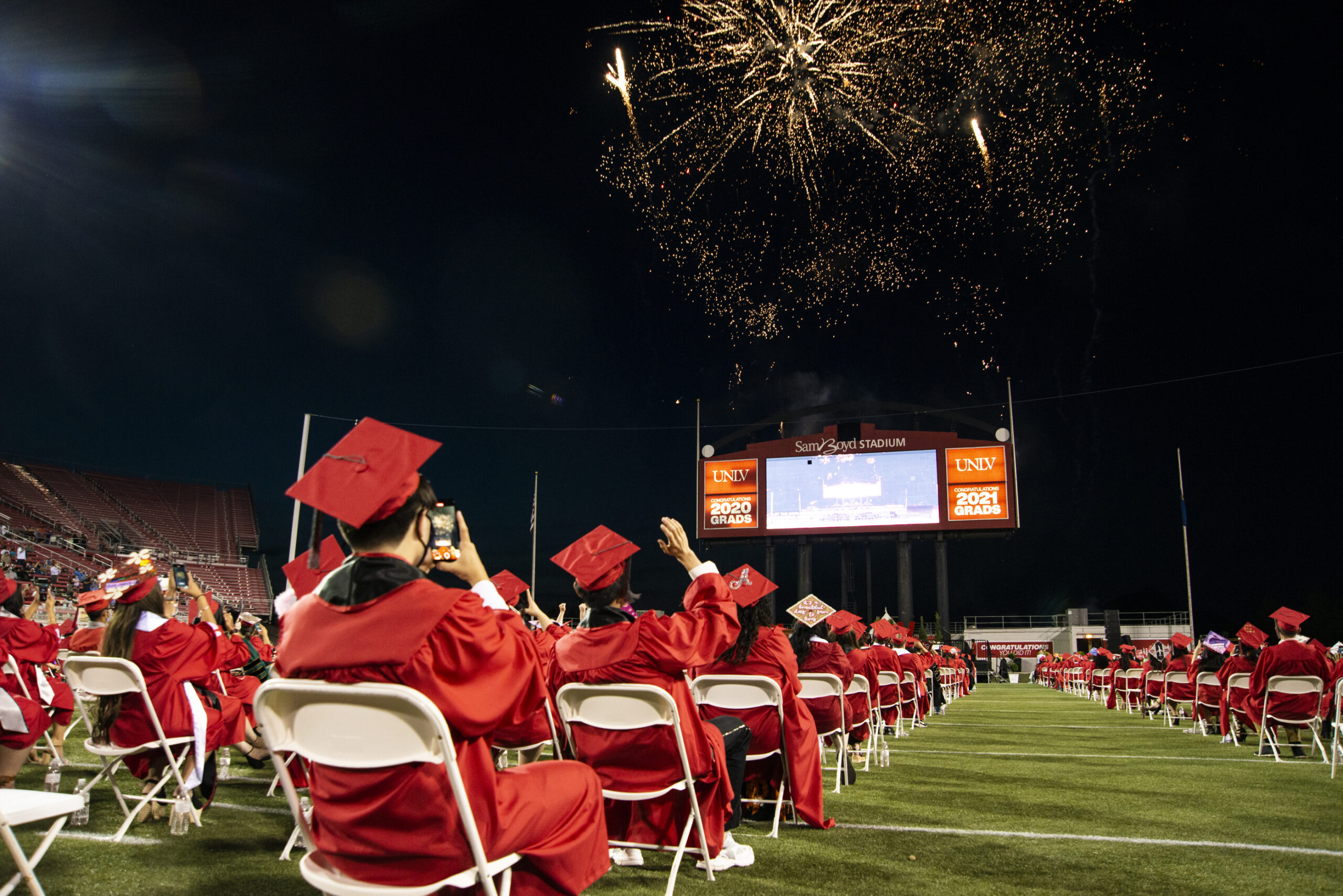Indy Explains: What Nevadans should know as student loan pause expires

After three years, the federal government’s student loan repayment pause is coming to an end June 30.
Come September, student loan servicers will begin to collect interest, and Nevadans with student loans will be expected to resume payments in October, per the U.S. Department of Education. As an expense borrowers have not had to consider in three years, economists are concerned repayment could boost defaults on all types of loans as well as depress discretionary spending, a potentially concerning trend for Nevada’s economy.
Nevadans are less likely to have student loan debt than residents of other states, with just 11.3 percent of residents (347,900 people) having loans, and nearly half of the state’s borrowers are under age 35, per the Education Data Initiative. Collectively, Nevadans owe $11.8 billion in student debt, and the average debt owed is $33,743 — ranking 32nd among states and the District of Columbia for debt per borrower.
As part of an early pandemic measure to ease economic burdens, the repayment pause removed a major expense that has deeply affected Nevadans. The state ranked first among all states in student loan default rates — one of the motivating factors for the state treasurer to set up an ombudsman’s office as a resource for borrowers to better understand their loans.
“It's helped everyone,” said Evelyn Castro, the Nevada student loan ombudsman. “During the pandemic, a lot of individuals lost their jobs, a lot of them were unemployed, some may have regained some type of employment and they might not [earn] the same amount — and then plus, with inflation, not having to pay this additional debt helped everyone out.”
But with payments resuming, economists and advocates alike are concerned in particular about younger borrowers being squeezed by a new recurring payment — particularly for those who graduated college in the last three years and have never made a payment on their student loans.
Further complicating borrowers’ calculus is an impending decision from the Supreme Court on a separate loan cancellation policy from the Biden administration that would wipe out up to $20,000 per borrower. The decision will set a major marker in the broader political debate about the merits of freeing up individuals’ debt burdens versus costing the federal government billions per month during the pause.
Still, there are federal and state-level programs that borrowers can take advantage of to ease the transition.
What borrowers should do
Betsy Mayotte, the president of the Institute of Student Loan Advisors, a nonprofit that provides free student loan advice, said one of the biggest challenges will be ensuring borrowers know about the administrative work required to smoothly transition back to making payments.
Mayotte said about 17 million accounts have changed servicers during the pandemic, meaning that all borrowers should log onto the Department of Education’s website to first see who holds their loans.
Secondly, they need to ensure that all of their contact information is up to date — particularly if they’ve moved or graduated since their last payment. Federal loan information can be updated with the Department of Education; Castro and Mayotte said those with private loans should react out directly to their servicers. In either case, borrowers should monitor their inbox and mail for communications on their new due dates.
Borrowers should also prepare to incorporate their monthly payment into their budgets. Whatever payment plan a borrower was on prior to the pause should resume this fall; for plans that require annual recertification of income or employment, there will be a grace period of one year where certification will not be required.
Still, Mayotte advised that borrowers use the federal government’s student aid website to consider new repayment plans if their financial circumstances have changed.
“The economy has changed dramatically since the pause started,” Mayotte said. “So whatever plans someone was on pre-COVID may not still be a good fit for them post-COVID.”
Castro is advising borrowers to not ask for further delays on repayment unless absolutely necessary. Interest can still accrue during a delay, making a borrower’s ultimate monthly payment or debt larger in the long term.
And the consequences for missing payments are severe: 90 days after a missed payment, servicers report delinquencies to credit bureaus. A 270-day delinquency is considered to be a default, opening the borrower up to government collection of assets including tax refunds and Social Security benefits, up to 15 percent of a borrower’s income, and, of course, a worsened credit score.
Repayment alternatives
Additionally, there are numerous programs and refinancing options available to borrowers, as well as an easing of the punishments for missed payments and defaults.
For those already in default, the Department of Education announced the Fresh Start program last year to suspend the federal government’s ability to collect on student loan borrowers’ debt. In addition, if borrowers opt in by contacting their loan holder, the Fresh Start program also enables changes to the credit reporting process so that a default is not quite as devastating to a borrower’s credit score.
Fresh Start participants — as well as those who have not defaulted but are struggling to make loan payments — may also be eligible for income-driven repayment (IDR). IDR sets a borrower’s monthly payment based on income and family size.
Borrowers qualify for these plans based on the size of their income relative to the size of their loans, with eligibility requirements for the plans ranging in strictness. Depending on their circumstances, a borrower’s monthly payment can range from 20 percent of their income to no monthly payment at all. Total repayment takes longer than the standard repayment plan, but any remaining balance on loans will be forgiven after 20 to 25 years.
For borrowers already on an IDR plan, they may need to recertify their employment or income, so Castro again urged borrowers to look for communications from their servicer.
Finally, borrowers who work full-time in the public sector — including for the federal government, the state, a local government, a Tribal nation, the military, or a nonprofit — may be eligible for the Public Service Loan Forgiveness (PSLF) program. For participants who have worked full time in the public sector and made on-time payments on their loans for 10 years, the federal government will forgive any remaining balance on their loans.
Critically, the past three years are included in that 10-year time span — even though borrowers were not making payments during that time — meaning a new group of borrowers is now eligible for PSLF.
But both Mayotte and Consumer Financial Protection Bureau (CFPB) economists cautioned that changes to repayment plans, as well as standard customer service requests, are likely to take longer than normal.
“The system just wasn't built for 40 million people all reentering repayment at the same time,” said Mayotte, who noted Congress did not appropriate additional funds for call center staffing or paperwork processing. “People are going to need to put their patience pants on.”
Both Mayotte and Castro also noted an increase in student loan scams as the pause comes to an end, and cautioned that legitimate student loan advice or access to forgiveness programs is always free.
Castro said she expects repayment to be confusing — aiding scammers — and added that her office is a free, confidential resource for Nevada borrowers to ask questions.
“[Borrowers should] be very vigilant of any text messages, phone calls, emails that they're receiving regarding cancellation [or] regarding repayment plans,” Castro said. “Just stay vigilant, know who's sending them. And if it's too good to be true, it probably is.”
Macroeconomic effects and political impacts
Given the lag time between missed payments and student loan delinquency and defaults, the full effect of ending the pause may take a year to unfold. But economists are concerned that a rise in delinquencies on other types of credit throughout the pandemic could lead to the delinquency rate rising on student loans once payments resume — an area of concern in Nevada, where default rates are already high.
Administratively, about 40 percent of borrowers nationwide have had a change in servicers, meaning they will need to be proactive in ensuring they know who holds their loans. And the CFPB that one in 13 student loan borrowers are already behind on other payments, such as for credit cards and auto loans, meaning the resumption of loan repayment could cause further strain.
Castro is particularly concerned about downstream economic effects on those other payments — such as credit card bills — being missed because the consequences of missing payments to the federal government are more severe.
“I think there's going to be a huge impact on Nevadans, and probably even those tourists that come out,” she said.
Macroeconomically, borrowers — particularly younger people who have never had to make payments on their loans — may have experienced “lifestyle creep,” when their spending rises in accordance with their income, and may find it difficult to adjust to a new monthly payment.
And of course, any time national consumer behavior is affected, it hits particularly painfully in Nevada, whose tourism-based economy is dependent on people having extra money to spend.
The Department of Education is expected to announce further policies related to easing the effects of ending the repayment pause, but the Supreme Court may throw a wrinkle into the Biden administration’s most notable student loan policy — debt cancellation.
Last year, Biden announced that qualifying borrowers could see up to $20,000 in their student loan debt wiped out, depending on their income. But that program, which would benefit 198,000 people in Nevada, has been in jeopardy since November as GOP-backed court cases have made their way to the Supreme Court. A decision on the legality of the program is expected this week.
Between the end of the pause and the potential for the Supreme Court to nullify debt forgiveness, young voters — a critical population for Biden’s re-election chances in 2024 — could bear the brunt of coinciding loan stresses.
Tanner Hale, the president of Young Democrats of Nevada, said student loan debt is a major issue for his caucus — and projects it will become even higher priority for young voters once the pause ends.
“We've largely adjusted our finances to not have that [forgiveness] take effect, and for the pause to be lifted,” Hale said. “It’s just hurtful, and it's damaging. There’s going to be a lot of people that when that wrench gets thrown back into their budget, it's going to make their lives really difficult.”
